Volumetric weight of asphalt concrete chips. Composition of asphalt concrete and state standards. Type of pavement structures with asphalt concrete pavement, area and conditions of their use
Asphalt is a natural or artificial material, which includes bitumen, as well as natural minerals (sand and gravel). Thanks to its exceptional chemical properties Asphalt has been used successfully in many areas. Road coatings, waterproofing and electrical insulation, the production of paints and varnishes and glues, and even painting - the scope of asphalt is extremely wide.
The weight of 1 cube of asphalt is 1100-1500 kg, and 1 cube of asphalt concrete weighs 2000-2450 kg.
How much does a kilogram of asphalt weigh? Before starting work, it is important to accurately determine the right amount of material in order to avoid its cost overruns or, conversely, shortages. However, we are talking about asphalt, so it is more convenient to use a cubic meter as a unit of measurement of volume. Today we consider the weight of the cube of asphalt and its "derivatives" - asphalt crumb and asphalt concrete. In addition, we learn some interesting facts about this truly universal material.
Asphalt: historical facts
In Greek, “asphalt” means “mountain resin,” and the ancient Egyptians and Babylonians were engaged in its extraction. The unique astringent properties made asphalt a popular material for covering the surface of walls of structures, roads, and making containers more durable. And how indispensable was the asphalt in shipbuilding! After all, ancient boats and ships, the hulls of which were impregnated with liquid asphalt, acquired exceptional moisture resistance.
Interesting: today in North America, the former USSR and Europe are natural deposits of asphalt. The Dead (or Asphalt) Sea is considered the most ancient source of asphalt.
How much does a cube of asphalt weigh?
Calculation of the mass of asphalt is always made with the aim of planning production work pavement a certain length. At the same time, the type of material used and the method of its production affect the weight of 1 m 3 of asphalt. As a rule, information on the mass of asphalt can be obtained from special tables or from the manufacturer, which will provide information on the specific gravity of the material of different grades.
As you can see, the weight of 1 cube of asphalt crumb is more than the weight of the cube of asphalt, and the mass of the cube of asphalt concrete significantly exceeds both that and the other indicator.
How much does a cube of asphalt chips weigh?
The weight of the cube of asphalt crumbs is from 1.5 to 1.9 tons.
This material is widely used for filling roads, since it has a huge advantage compared to sand or gravel - more dense laying. As a result, a road coated with asphalt crumb over time practically does not differ from asphalt.
Asphalt crumb is obtained by recycling old asphalt pavement and is used for filling roads inside summer cottages, parking lots, as well as for repair purposes. Due to the presence of bitumen, crumb from asphalt is highly resistant to blurring and other destructive phenomena.
In addition, an important factor when using asphalt crumb is its cost - almost three times less than the price of crushed stone! Moreover, such a low cost only indicates the availability and "cost-free" production of this amazing material. Simply chop the old asphalt pavement - and great stuff is ready.
When falling asleep crumbs from asphalt should be aware of its high density. Therefore, it is better to apply the material to the place of filling, not forgetting that the crumb gives a significant precipitate - from 30 cm of the material that is deposited after rolling it can be only 15 cm. So only observing this simple rule guarantees high-quality repair of the road surface.
How much does a cube of asphalt weigh?
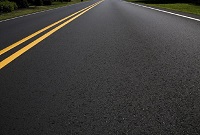 The weight of 1 cube of asphalt varies from 2.0 to 2.4 tons.
The weight of 1 cube of asphalt varies from 2.0 to 2.4 tons.
Asphalt concrete is a mixture of natural minerals and bitumen, giving the material exceptional strength. Therefore, asphalt concrete is able to withstand significant modern loads on the road. Such amazing properties are possessed by polymer additives that are part of cast asphalt concrete. In this case, the content of fine-grained gravel can be 50 - 0% by weight. As a result, the material is viscous, not requiring compaction.
Using asphalt concrete, various decorative elements are made - sidewalks, alleys, paths, pedestrian crossings and dividing strips.
So, we learned how much a kilogram or cube of asphalt weighs, about its useful properties, as well as other interesting facts about this unique material.
Asphalt concrete is widely distributed throughout the world as a material for the construction of roads and landscaping. It is a mixture road bitumen and natural minerals. Next, we will consider its composition, and find out the weight of asphalt concrete 1 m3, which is important when performing various calculations.
Asphalt concrete pavement
Material Composition
So, the coating consists of the following ingredients:
- Fine gravel or gravelwhich are crushed into crumbs;
- Sand (quartz or slag);
- Bitumen - resinous substance.
Natural components of this material provide strength, and bitumen is their binder component. Like all resins, bitumen has a viscous consistency only when heated. Therefore, the mixture is laid only in a preheated state.
It should be noted that there are technologies by which it is possible to obtain bitumen, which retains its viscosity up to +5 degrees Celsius. In addition, some modern methods Oil refining allows you to create liquid bitumen that does not freeze at temperatures up to -30 degrees Celsius.
Note! The technology of laying the pavement in different countries is approximately the same, however, the quality of the canvas depends largely on the composition of the mixture, to which modern components are added to improve its characteristics.
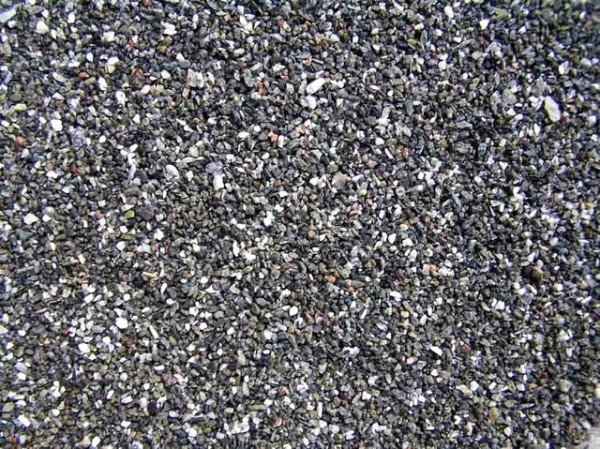
In the photo - small crushed stone
Depending on the content of mineral components in the mixture, it is divided into 3 groups:
As for the size of gravel or gravel fractions for concrete, this parameter is regulated by TU-5718.030.01393697-99, which was developed by SoyuzdorNII. In accordance with it, I add crushed stone with a particle size of 10-20 mm to the mixture. Such material is used to apply the top coat. roadbed.
It should be noted that there is still coarse-grained asphalt concrete in which crushed stone of fractions up to 40 mm in size is used. It is also used in road construction. This technology is considered traditional, as a result of which it is used everywhere.
True, depending on the operating conditions of the roadway, polymers and surfactants can be added to the composition of the mixture, giving it certain properties. In many ways, the price of the material depends on the additives.

Asphalt Paving
Physico-mechanical properties Weight and density
The quality of the coating largely depends on the physical and mechanical properties, which are regulated by GOST 9128-97. According to these standards, the density, and therefore the weight of 1 m3 of asphalt concrete, depends on the sand that is used in its composition.
Depending on this, the weight is:
- On quartz sand, 2200 kg per cubic meter;
- On slag sand 2350 kg per cubic meter.
The second indicator is greater as a result of the fact that the mixture on slag sand is more compacted. Of course, specific gravity coarse-grained asphalt concrete is different, since crushed stone of a larger fraction is used in it. It is very difficult to obtain the exact value, however, on average, the weight is 2100 kg per cubic meter.
These figures are important in calculating the required amount of material for the performance of certain works. In addition, data on weight may be required when disassembling the pavement, which will allow you to calculate the carrying capacity of the equipment and the number of cars for the removal of the old pavement.
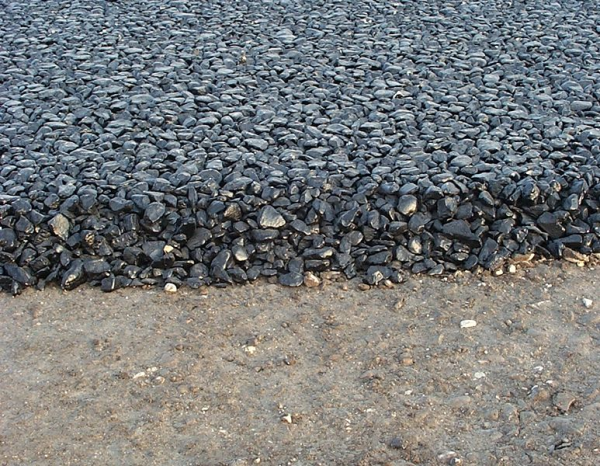
Coarse coating
Note!
The consumption rates according to which this material is laid depend on the brand of the mixture.
These data can be found out from SNiP 3.06.06-88, which will allow to avoid errors when performing calculations and do-it-yourself jobs.
I must say that to increase the roughness of the road surface and, accordingly, better adhesion of car tires to the road, an increased amount of crushed crushed stone is added to the asphalt mixture. Its content can reach 80 percent. Grip is sometimes improved by adding recycled tires to the composition.
A change in composition, of course, affects the density and weight of the concrete material. Therefore, accurate values \u200b\u200bcan only be obtained from the manufacturer of the mixture.
![]()
Asphalting the site
Material consumption
If you decide to improve the territory by completing paths from asphalt concrete or covering the site with them, first you need to calculate its consumption. This will allow you to find out the quantity and cost of the material to carry out the planned work.
The instructions for calculating the flow are extremely simple:
- First of all, it is necessary to measure the area that is planned to be covered with asphalt concrete. For example, it is necessary to cover a site of 50 square meters, with a layer thickness of 1 cm.
- To cover one square meter of the road, 25 kg of mixture will be needed, respectively, for 50 meters, 25x50 \u003d 1250 kg will be needed
- Since in 1 m3 there is an average of 2250 kg of asphalt concrete, to cover the site you will need 1250: 2250 \u003d 0.55 m3 of asphalt concrete.
![]()
Decorative asphalt pavement
It must be said that when using cast asphalt concrete, i.e. mixtures, which include polymers and plasticizers, consumption decreases, since the coating can be used with a thinner layer, as a result of its ductility.
Advice!
When landscaping with asphalt concrete pavement, it can be decorated.
To do this, color is usually added to its composition.
Also a popular way of decorating it is embossing and the use of colored gravel with fractions up to 5 mm in size.
The weight of a material such as asphalt depends primarily on the components that are used in its composition. However, averaged data can be obtained from the reference literature. This information is sufficient to perform basic necessary calculations when performing various tasks.
From the video in this article, you can get additional information on this topic.
For landscaping and road construction today, asphalt concrete is widely used, which allows you to get a durable and high-quality coating. This material is a mixture of bitumen and natural materials.
Natural ingredients provide strength, while bitumen is needed to bind them in a single design. Asphalt concrete is laid according to the same technology in different countries, but the quality of the coating depends on the components that are added or not added to the mixture, this sometimes determines the laying method.
Material density
The density of asphalt concrete is one of the main characteristics of this material. Asphalt concrete, this is what it is also called, has the appearance of a building artificial conglomerate, which is formed as a result of achieving the necessary density of the mixture laid in the structure. The composition is prepared by mixing in special installations under the influence of temperature. In this case, mineral materials of different fractions are also used, they are selected in certain ratios. Sometimes polymers, rubber, surfactants, sulfur, etc. are added.
The density of asphalt concrete depends on the variety. For example, a dense mixture has a density in the range of 2340 kg / m 3, as porous mixture, then its density is slightly lower - 2300 kg / m 3. Fine-grained asphalt mixture of type A, B and C has the following density indicators: 2385, 2370 and 2343 kg / m 3, respectively. There is also sandy asphalt concrete in the “mix type D” variety, in which case the parameter of interest is 2280 kg / m 3.
Density determination
Determination of the density of asphalt concrete is carried out according to laboratory tests of those samples that were removed from the coatings. This parameter is calculated by the ratio of the average that was taken from the coating to the average density of the reformed sample.
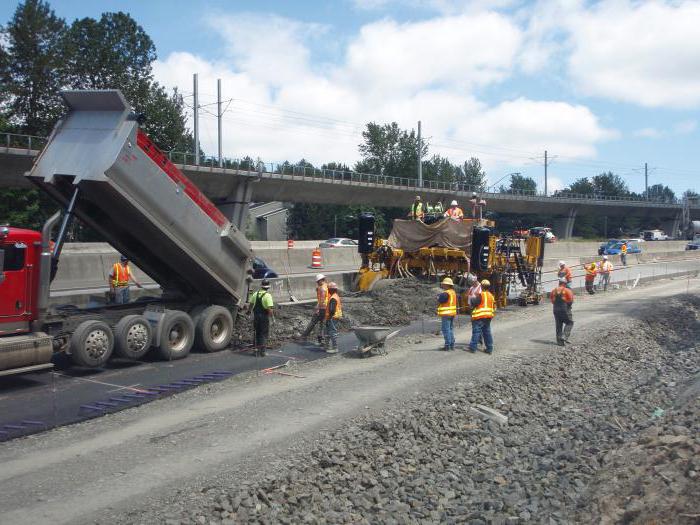
Each type of mixture has its own compaction coefficient. For example, for mixtures A and B, the coefficient is 0.99, for a mixture of B, D and D, the main and lower layers, the coefficient is 0.98. If among the ingredients contains crushed stone from artificial stones, then the coefficient should be equal to 0.97.
Asphalt Consumption
It is important not only the density of fine-grained asphalt concrete and its other varieties, but also the consumption. Usually this parameter is determined per 100 m 2, but the thickness of the layer may vary. For a dense and porous mixture with a layer thickness of 55 mm, the consumption per 100 m 2 will be 12.87 and 12.65 tons, respectively. With an increase in the layer to 80 mm, the flow rate of the dense and porous mixture will be 18.7 and 18.4 tons, respectively.
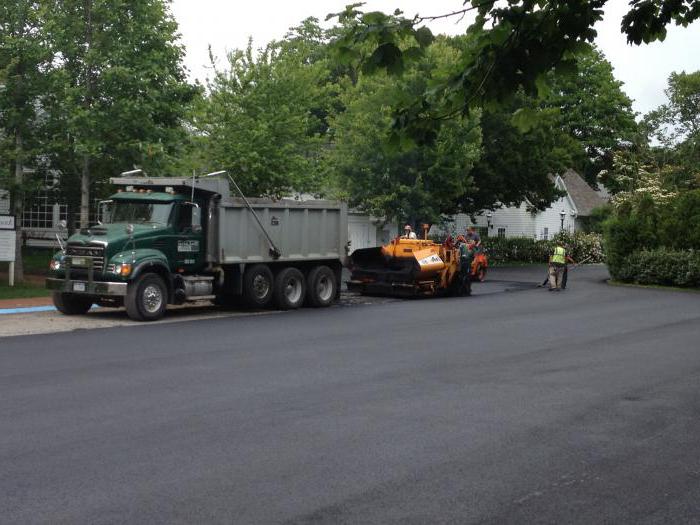
Type A fine-grained asphalt mix has a lower consumption if the layer is reduced to 35 mm. At the same time, 8.35 tons will be consumed per 100 m 2. And if it comes to sand asphalt mix type D, then with a layer thickness of 45 mm, the flow rate will be 10.26 tons for every 100 m 2.
Density meter
Asphalt density meter can be purchased at specialized stores. It determines the density of the coatings and the foundations of the roadway. The purpose of the device is the operational control of density, during which you can find out the degree of heterogeneity and compaction of the bases and road surfaces.
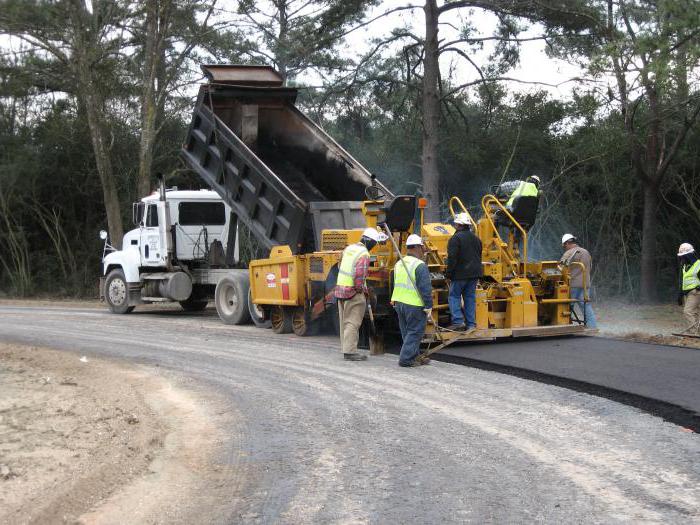
The device can identify uncompressed areas, as well as control critical areas, edges and joints should be included here. Using it, the average density of asphalt concrete can be determined, which is 2.35 g / cm 3. The equipment evaluates how well the coating is before applying the top coat. The device can measure the temperature of the asphalt, determine the compaction coefficient, and carry out the thermal compensation of the density readings.
Asphalt Composition and State Standards
The density of asphalt concrete, GOST which determines the quality of the material and is indicated by the following numbers: 9128-2009, - was mentioned above. However, specialists should also know about the composition. The coating has gravel or crushed stone among the ingredients that are crushed and are crumbs. There are sand in the composition.
As mentioned above, bitumen acts as a resin-like product that holds components together. However, for this, the material must be brought to a heated state. This also determines the technology of laying asphalt concrete. But today there is a technology that allows you to get bitumen with a viscosity of up to +5 ° C. Oil is refined by modern methods, which makes it possible to obtain liquid bitumen that does not solidify to critically low temperature levels. Usually this value is -30 ° C.
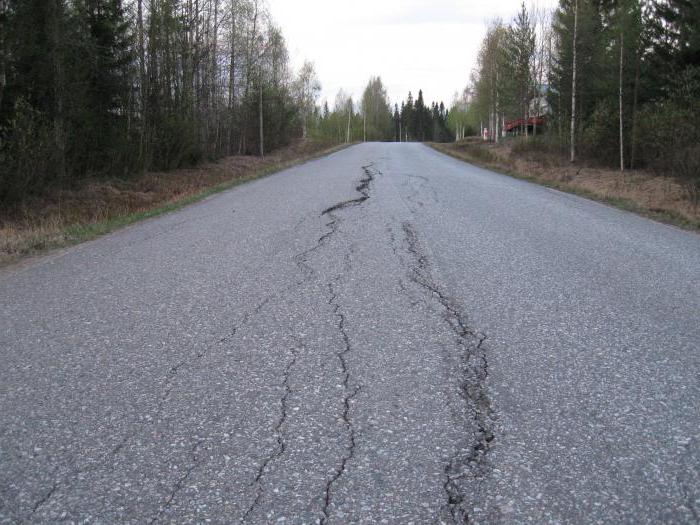
The density of asphalt concrete (t / m3) is 2.35. But this value is not the only one that professionals should know about. For example, the content of minerals is divided into three values:
- group A: from 50 to 60% (crushed stone or gravel);
- group B: from 40 to 50% (minerals);
- group B: from 30 to 40% (gravel or gravel).
Crushed stone fractionality is regulated by technical conditions. In accordance with them, the material is made using crushed stone, the granularity of which can vary from 10 to 20 mm. Such a composition is used to form the top layer of the web. The technology is traditional and is used everywhere today, but polymers can be added to the mixture.
Change in asphalt concrete under the influence of modern technologies
According to state standards, the density of asphalt concrete should remain the same, but the quality of the material is constantly improving. This is due to the constantly increasing loads on the pavement, which led to the search for modern materials to improve quality. As a result, it was possible to create cast asphalt concrete, which was discussed above.

It is used not only for construction, but also for road repair. This technology is regulated by state standards R 54401-2011 and involves the installation of the mixture without sealing. The conglomerate temperature in this case starts from 190 ° C, an increase in this level increases plasticity. The composition is characterized by such features due to polymer additives.
Cast asphalt contains more bitumen, but the volume of minerals decreases. The content of crushed stone fractions up to 5 mm is from ½ part of the total mass to 0%. The mixture is not so granular, so it is viscous and does not require compaction.
Additional ingredients
Bitumen binder improves physical properties, so the material gives the coating high strength, wear resistance, integrity and a long service life without cracks. The density of the asphalt concrete remains the same, but for this it is important to observe the technology, as well as the proportions. This is the vulnerability of the material, which distinguishes cast asphalt. If at the production stage a deviation from the norms occurs, then the strength characteristics will suffer.
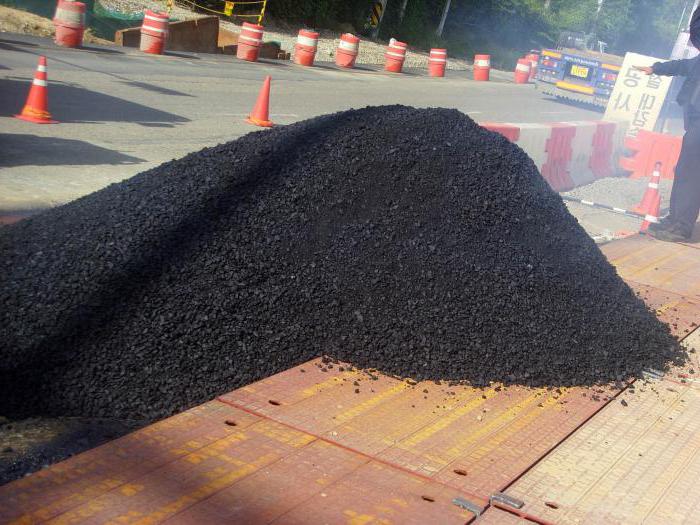
Conclusion
The advantage of asphalt concrete is that it can be decorated. This greatly expanded the scope of its use, because with the help of the material you can draw beautiful paths, sidewalks and alleys. On the roadway with the use of such technology, colored asphalt concrete appeared, which indicates pedestrian crossings, markings and dividing strips.
The technology involves adding 5-mm gravel, pigments and sand from granite, clinker, marble and limestone to the composition. To obtain bright-colored asphalt concrete, synthetic clarified bitumen is used. The technology increases the cost of coating, so it is rarely used.
But today I managed to find distribution in a different way. It involves rubbing colored chips, while its addition was refused during manufacture. At the stage of laying the road, an addition to the top layer of the coating takes place.
Asphalt concrete is widely distributed throughout the world as a material for the construction of roads and landscaping. It is a mixture of road bitumen and natural minerals. Next, we will consider its composition, and find out the weight of asphalt concrete 1 m3, which is important when performing various calculations.
Material Composition
So, the coating consists of the following ingredients:
- Fine gravel or gravelwhich are crushed into crumbs;
- Sand (quartz or slag);
- Bitumen - resinous substance.
Natural components of this material provide strength, and bitumen is their binder component. Like all resins, bitumen has a viscous consistency only when heated. Therefore, the mixture is laid only in a preheated state.
It should be noted that there are technologies by which it is possible to obtain bitumen, which retains its viscosity up to +5 degrees Celsius. In addition, some modern methods of oil refining make it possible to create liquid bitumen that does not freeze at temperatures up to -30 degrees Celsius.
Note! The technology of laying the pavement in different countries is approximately the same, however, the quality of the canvas depends largely on the composition of the mixture, to which modern components are added to improve its characteristics.
In the photo - small crushed stone
Depending on the content of mineral components in the mixture, it is divided into 3 groups:
As for the size of the fractions, this parameter is regulated by TU-5718.030.01393697-99, which was developed by SoyuzdorNII. In accordance with it, I add crushed stone with a particle size of 10-20 mm to the mixture. Such material is used to apply the top layer of the roadway.
It should be noted that there is still coarse-grained asphalt concrete in which crushed stone of fractions up to 40 mm in size is used. It is also used in road construction. This technology is considered traditional, as a result of which it is used everywhere.
True, depending on the operating conditions of the roadway, polymers and surfactants can be added to the composition of the mixture, giving it certain properties. In many ways, the price of the material depends on the additives.
Physical and mechanical properties
Weight and density
The quality of the coating largely depends on the physical and mechanical properties, which are regulated by GOST 9128-97. According to these standards, the density, and therefore the weight of 1 m3 of asphalt concrete, depends on the sand that is used in its composition.
Depending on this, the weight is:
- On quartz sand, 2200 kg per cubic meter;
- On slag sand 2350 kg per cubic meter.
The second indicator is greater as a result of the fact that the mixture on slag sand is more compacted. Of course, the specific gravity of coarse-grained asphalt concrete is different, since crushed stone of a larger fraction is used in it. It is very difficult to obtain the exact value, however, on average, the weight is 2100 kg per cubic meter.
These figures are important in calculating the required amount of material for the performance of certain works. In addition, data on weight may be required when disassembling the pavement, which will allow you to calculate the carrying capacity of the equipment and the number of cars for the removal of the old pavement.
Note!
The consumption rates according to which this material is laid depend on the brand of the mixture.
These data can be found out from SNiP 3.06.06-88, which will allow to avoid errors when performing calculations and do-it-yourself jobs.
I must say that to increase the roughness of the road surface and, accordingly, better adhesion of car tires to the road, an increased amount of crushed crushed stone is added to the asphalt mixture. Its content can reach 80 percent. Grip is sometimes improved by adding recycled tires to the composition.
A change in composition, of course, is reflected in the material. Therefore, accurate values \u200b\u200bcan only be obtained from the manufacturer of the mixture.
Material consumption
If you decide to improve the territory by completing paths from asphalt concrete or covering the site with them, first you need to calculate its consumption. This will allow you to find out the quantity and cost of the material to carry out the planned work.
The instructions for calculating the flow are extremely simple:
- First of all, it is necessary to measure the area that is planned to be covered with asphalt concrete. For example, it is necessary to cover a site of 50 square meters, with a layer thickness of 1 cm.
- To cover one square meter of the road, 25 kg of mixture will be needed, respectively, for 50 meters, 25x50 \u003d 1250 kg will be needed
- Since in 1 m3 there is an average of 2250 kg of asphalt concrete, to cover the site you will need 1250: 2250 \u003d 0.55 m3 of asphalt concrete.
It must be said that when using cast asphalt concrete, i.e. mixtures, which include polymers and plasticizers, consumption decreases, since the coating can be used with a thinner layer, as a result of its ductility.
Advice!
When landscaping with asphalt concrete pavement, it can be decorated.
To do this, color is usually added to its composition.
Also a popular way of decorating it is embossing and the use of colored gravel with fractions up to 5 mm in size.
Conclusion
The weight of a material such as asphalt depends primarily on the components that are used in its composition. However, averaged data can be obtained from the reference literature. This information is sufficient to perform basic necessary calculations when performing various tasks.
From the video in this article, you can get additional information on this topic.
Today, the transport network is one of the indicators of the level of economic development. High-quality road surface contributes to an increase in freight traffic and reduces transportation costs, and in urban infrastructure increases the throughput of congested streets. For over a hundred years, asphalt has been used as pavement.
Asphalt composition
This material may be of natural or artificial origin. In the first case, asphalt is a mixture of mineral materials with bitumen, the content of which can be up to 75%. Material of artificial origin, also called asphalt concrete, is made from mineral or polymer additives, bitumen. The content of the latter in it is usually 5-15%. Currently, asphalt of natural origin is practically not used in the construction of pavements.
Why do you need to know how many cubes per ton of asphalt?
When the device determines the volume of the required material based on the asphalt area and the thickness of the layer. But asphalt plants release the mixture in units of mass - tons. To get the right amount, you need to determine how many cubes in one ton of asphalt. A calculation error can be expensive. In case of insufficient amount of asphalt concrete the material will have to be ordered additionally. And this is not only unnecessary transportation costs, but also an unnecessary joint on the coating. If the ordered mixture is surplus, the excess material will remain unused.
In addition to the technical side of the issue, how many cubic meters per ton of asphalt, it is necessary to know for the preparation of estimates for construction.
Classification of asphalt mixtures
To answer the question "How many cubes per ton of asphalt?", You need to know the density. Depending on the filler and additives used, it can vary significantly. Classification of asphalt mixtures takes into account the size and content of the filler.
Depending on the size of the filler, asphalt concrete is divided into:
- Coarse-grained, with a grain size of up to 40 mm.
- Fine-grained, fraction up to 20 mm.
- Sand, maximum size up to 10 mm.
- A - from 50 to 60% (only crushed stone);
- B - from 40 to 50% (crushed stone or gravel);
- B - from 30 to 40% (crushed stone or gravel);
- G - sand from screenings crushing;
- D - natural sand.
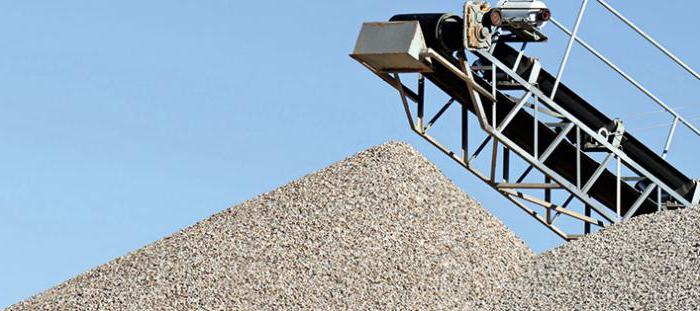
Convert cubic meters to tons of asphalt
In addition to the main characteristics, the specific gravity of asphalt concrete is affected by the content and grade of bitumen, the composition of mineral or polymer additives, and the temperature of the mixture. The specifics of local materials used in asphalt plants in each region are also taken into account. Therefore, the most correct solution is to call the nearest asphalt concrete plant and ask "1 cube of asphalt - how many tons?"
Despite the variety of grades of asphalt, in VSN 14-95 “Instructions for the construction of road asphalt pavements” the following density values \u200b\u200bare given.
Fine-grained mixture:
- type “A” - 2 385 kg / m3;
- type “B” - 2,370 kg / m3;
- type "B" - 2 343 kg / m3.
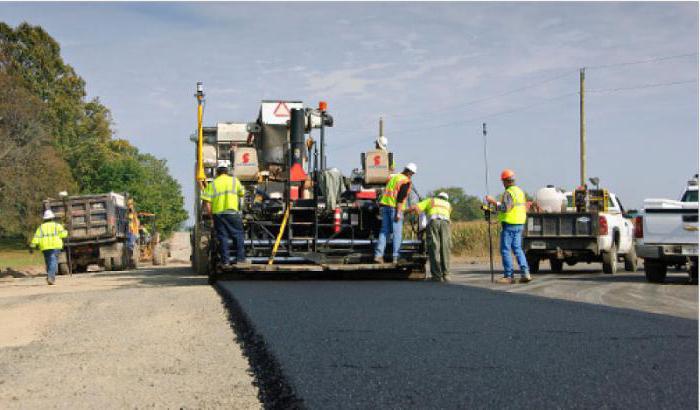
Using old asphalt
In addition to installing a new pavement, it is often necessary to dismantle an existing asphalt layer. Dismantling is carried out by special equipment by the milling method. This material can be used to fill the lower layers of pavement, used to prepare a new asphalt mix, or simply taken to a landfill for disposal. In any case, you need to know the mass of the removed asphalt. Unfortunately, it is impossible to determine exactly how many cubes per ton of asphalt of the old pavement due to the heterogeneity of the surfaces and differences in the sizes of the milling drum. In the averaged calculations, a conversion factor of 2.2 t / m3 is used.




